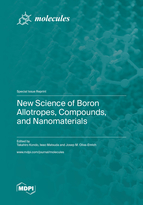New Science of Boron Allotropes, Compounds, and Nanomaterials
A special issue of Molecules (ISSN 1420-3049). This special issue belongs to the section "Materials Chemistry".
Deadline for manuscript submissions: closed (31 May 2023) | Viewed by 25618
Special Issue Editors
Interests: surface science; molecular beam scattering; nitrogen-doped carbon; hydrogen boride; boron hydride; borophene; borophane; two-dimensional materials; reaction dynamics
Interests: atomic layer; surface; spectroscopy
Special Issue Information
Dear Colleagues,
Boron is known to have a large number of allotropes. Boron compounds and boron nanomaterials are also known to show polymorphs because, compared to other compounds, they form a wide variety of chemical bonds with each other. Thus, there are several important research subjects in theoretical, computational, and experimental physics and chemistry. A recent example is the realization of two-dimensional planar boron nanomaterials (borophene), showing polymorphisms as expected. This Special Issue aims to provide a forum for the dissemination of the latest information on boron allotropes, compounds, and nanomaterials.
Dr. Takahiro Kondo
Prof. Dr. Iwao Matsuda
Dr. Josep M. Oliva-Enrich
Guest Editors
Manuscript Submission Information
Manuscripts should be submitted online at www.mdpi.com by registering and logging in to this website. Once you are registered, click here to go to the submission form. Manuscripts can be submitted until the deadline. All submissions that pass pre-check are peer-reviewed. Accepted papers will be published continuously in the journal (as soon as accepted) and will be listed together on the special issue website. Research articles, review articles as well as short communications are invited. For planned papers, a title and short abstract (about 100 words) can be sent to the Editorial Office for announcement on this website.
Submitted manuscripts should not have been published previously, nor be under consideration for publication elsewhere (except conference proceedings papers). All manuscripts are thoroughly refereed through a single-blind peer-review process. A guide for authors and other relevant information for submission of manuscripts is available on the Instructions for Authors page. Molecules is an international peer-reviewed open access semimonthly journal published by MDPI.
Please visit the Instructions for Authors page before submitting a manuscript. The Article Processing Charge (APC) for publication in this open access journal is 2700 CHF (Swiss Francs). Submitted papers should be well formatted and use good English. Authors may use MDPI's English editing service prior to publication or during author revisions.
Keywords
- Boron nanomaterials
- Borophene
- Borophane
- 2D boron compounds
- Borane
- Boride
- Planar 2D
- boron molecules
- Hybrid boron–carbon 2D system
- Boron clusters
- Bonding in boron 2D compounds and molecules
- Interaction of boron 2D and 3D systems with light and electrons









